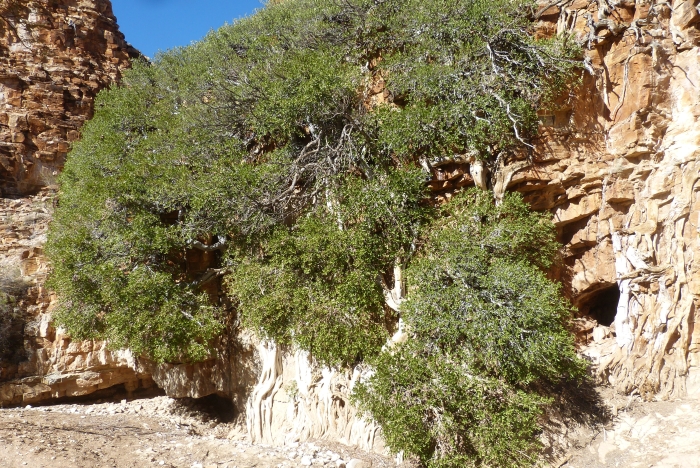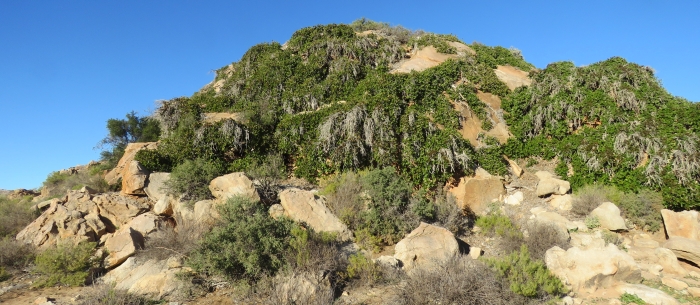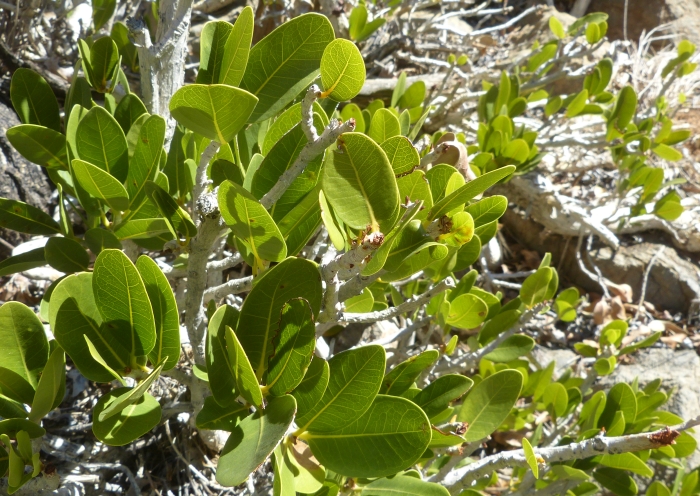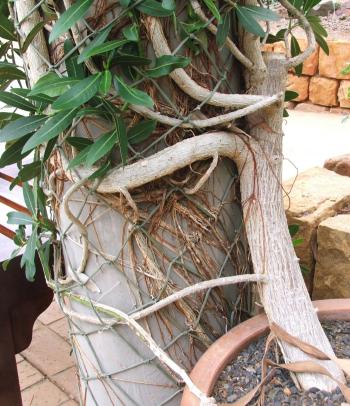Ficus ilicina
Ficus ilicina (Sond.) Miq.
Family: Moraceae
Common names: laurel fig, natarra fig (Eng.); louriervy, natarravy (Afr.); natarra (Nama)
SA Tree No: 53
Introduction
The laurel fig is an evergreen, rock-hugging fig from the summer-dry Namaqualand region and further north into Namibia and southern Angola, where rainfall is mainly in summer. It is a spreading, rock splitting plant, always on rock outcrops and boulders, with dark green, laurel-shaped leaves, small reddish-brown figs and flattened roots wrapped over the rocks.

Description
Description
Spreading, rock-hugging, evergreen shrub, up to several meters in diameter, sometimes small trees about 4 or 5 m tall. Initially developing a semi-succulent caudex in a rock crevice. The roots opportunistically wander, seeking out deeper crevices and can form an extensive network over the rocks. The bark is grey-white, smooth.

The ascending, spreading leaves are elliptic-oblong, 43–85 × 13–28 mm, with a leathery texture, dark green, with an entire margin. The petiole is short and robust, 5–10 mm long. The leaf tip is obtuse, to subacute, the base tapering.

Fruits with short stalks (5 mm long) from the axils, usually 2 to 4, rounded and about 10 mm in diameter, light yellowish green when ripe, becoming slightly purplish tanned. Fruits ripen in spring, but can fruit at any time of the year. When damaged, most parts exude a milky latex.
Conservation Status
Status
Ficus ilicina is widespread and fairly common and therefore, not threatened, and is thus assessed as Least Concern (LC) on the Red List.

Distribution and habitat
Distribution description
Widespread in semi-arid to arid regions of the western parts of South Africa, Namibia and southern Angola, from the Rooiberg, just north of Vanrhynsdorp to the Orange River and further north. It grows in Succulent- andNama Karoo Biomes and in dry semi-desert and Savanna Biome in the north (N. Namibia, S. Angola).
Its habitat is exclusively rock faces, boulders and granite domes. Seed germinates in crevices and the young plants initially develop a semi-succulent caudex, which is the case with many other rock-splitting or lithophytic figs. This enables the plant to survive during the dry season. Wandering roots seek out new territory, entering new crevices, until the plant is well rooted. The wandering roots often grow down a cliff face taking several years to reach the base. It has been recorded on various geological formations, such as granite, quartzitic sandstone, limestone and dolomite. Ficus ilicina shares its habitat in Namaqualand with Ficus cordata, the latter an erect, ascending tree with lighter green, ovate to heart-shaped leaves. In northern Namibia Ficis ilicina also shares its habitat with F. glumosa and F. bubu.

Derivation of name and historical aspects
History
Ficus belongs to the mulberry family, Moraceae, a large family mainly confined to the tropics and subtropics. This family consists of 37 genera and 1 180 species. Ficus represent the largest in the family with about 850 species (Christenhusz 2017).
The botanical name Ficus is probably derived from the Hebrew ‘fag’ or Persian ‘fica’. The specific name ilicina pertains to the leaves of the laurel fig, which resemble those of the holm oak, Quercus ilex. The common name laurel fig pertains its resemblance to the laurel, (Laurus nobilis), in the Lauraceae family.
Ficus ilicina was first named as Urostigma ilicinum by the botanist Sonder, in 1850, from plants collected by the German collector Carl Zeyher. It was transferred to Ficus in 1867. Another species from Namibia, Ficus guerichiana, was named by Engler in 1894, but later found to be a synonym of F. ilicina. However, there are small differences between the 2 taxa. The Namibian plants have broader leaves, tend to grow more erect and the stems are slightly hairy at the nodes. The Namaqua plants have narrower leaves, the stems are hairless and they tend to be more of a rock hugger. These characteristics are retained in cultivation.

The laurel fig (both from Namibia and Namaqualand) can be seen in the Botanical Society Conservatory as well as in the Matthews Rockery, in Kirstenbosch National Botanical Garden.

I planted these in 1997 on the entrance pillars of the Conservatory and some others on the western flank, training them up an attached net, and in the Matthews Rockery.

The result: a green pillar to the roof top in about 10 years, and the plant producing and extensive network of adventitious wandering roots, which eventually (in the last 8 years) have spread onto the concrete ceiling (where no free water ever reaches). This network of roots can clearly be seen on the pillars but more clearly on the ceiling of the concrete roof, and clearly represents a strategy so many of the rock-splitting and epiphytic figs follow. Opportunistic roots will exploit each little crevice or portion of the rock closest to the fig, searching for additional moisture sources.
These plants grown in the Conservatory, represent 2 collections, one of these from a collection of seed by Werner Voigt (a student at the time), which he brought back after an 8 day walk in the Namib Naukluft National Park, in 1997. This plant has broader leaves and is slow growing. The other collection is grown from cuttings collected by me from plants in Namaqualand. The latter is much faster growing and have narrower leaves. These plants were established in large containers, but the wandering roots soon found the adjacent sandstone fringed beds, where it soon enlarged. Ficus ilicina was also grown with success in the open, just south of the Botanical Society Conservatory, on a stone-dressed wall, as well as the Matthews Rockery where the plants can also be seen. The latter represent the Namibian slow-growing form and can be seen among the rocks just NW of the largest naboom (Euphorbia ingens).
Ficus ilicina appears to be closest to the veld fig (Ficus burtt-davyi) from the southern and eastern parts of South Africa. The latter with much smaller leaves and stems.
Ecology
Ecology
Seedlings that germinate in rock crevices, especially on cliffs, have the advantage of being out of reach of many herbivores. The plant also benefits by the wandering roots penetrating deep crevices where moisture is obtained. In Namaqualand it often hug parts of the granite domes or other outcrops. Plants benefit from water running down to the base of the outcrops. Seedlings in crevices have an extensive root system often growing over rocks to the bottom of the boulders. The plant initially grows from a semi-succulent caudex in a rock crack, this enables the plant to gradually increase in size, eventually enabling the plant to grow sufficient adventitious roots reaching new territory and deep rooting within the rock cracks, enabling it to grow bigger. If not, the plant can survive as a natural bonsai growth. The laurel fig grows on granite, sandstone, dolomite and limestone. Ficus ilicina is frost sensitive, and in higher lying areas of its habitat, the damage can be seen when the plants become pruned back against the rocks.
The laurel fig is pollinated by the minute wasp Elissabethiella enriqesii (Burrows & Burrows 2003).
The milky latex so characteristic in most figs, is a protective alkaline sticky sap, sealing its wounds.
Uses
Use
Occasionally propagated and cultivated and used as a bonsai subject. Fruits are eaten and dispersed by fruit-eating birds, humans, and also by baboons.
Growing Ficus ilicina
Grow
The laurel fig is well-suited for dry Succulent Karoo gardens in areas where frost is not too severe (Van Jaarsveld 2010). It is a slow grower, and ideal for rocky gardens. It can be grown with success in the Cape Town region especially the city bowl, or the hotter and drier western slopes in areas such as Bakoven and Llandudno. Best to plant among rocks or gabions. The laurel fig can also be grown with success as a potted plant. It is slow growing and can also be grown as a bonsai subject.
Propagate from seed or cuttings. Crush the dried fruits and sow during spring or summer in shallow trays. Cover with a thin layer of sand (1–2 mm thick) and keep moist. Germination is rapid (when seed is viable). Plant out when big enough to handle (Van Jaarsveld 1983, 2010).
Vegetative propagation is achieved by semi-hardwood cuttings. Prepare semi-hardwood cuttings of about 10–15 cm long in spring or summer. Remove the leaves on the lower half of the stems and plant in a mixture of polystyrene and peat. Rooting in a hot bed is within 2–3 weeks.
References
- Burrows, J. & Burrows, S. 2003. Figs of southern and south-central Africa. Umdaus Press, Hatfield.
- Clarke, H. & Charters, M. 2016. The illustrated dictionary of southern African plant names. Flora & Fauna Publications Trust, Jacana, Johannesburg.
- Coates Palgrave, M. 2005. Keith Coates Palgrave trees of southern Africa edition 3. Struik, Cape Town.
- Le Roux, P. & Muller, M. 2009. Trees, shrubs of Namibia. Macmillan Education Namibia, Windhoek.
- Lotter, J.de V. 2012. The fig in South Africa. Western Cape Department of Agriculture, Cape Town.
- Palmer, E. & Pitman, N. 1972. Trees of southern Africa. Balkema, Cape Town.
- Van Jaarsveld, E.J. 1983. The cultivation and uses of South African Figs. Trees in South Africa. Vol 34: 63–78.
- Van Jaarsveld, E.J. 2010. Waterwise gardening in South Africa and Namibia. Struik, Cape Town.
- Van Wyk, P. & Van Wyk, B. 2013. Field guide to trees of southern Africa. Struik Publishers, Cape Town, Johannesburg.
Credits
Ernst van Jaarsveld
Kirstenbosch National Botanical Garden (Retired)
Babylonstoren Farm
Extraordinary senior lecturer and researcher, Department of Biodiversity and Conservation, University of the W. Cape.
November 2018
Plant Attributes:
Plant Type: Shrub, Tree
SA Distribution: Northern Cape, Western Cape
Soil type: Sandy, Loam
Flowering season:
PH: Acid, Alkaline, Neutral
Flower colour:
Aspect: Full Sun
Gardening skill: Average
Special Features:
Horticultural zones











Rate this article
Article well written and informative
Rate this plant
Is this an interesting plant?
Login to add your Comment
Back to topNot registered yet? Click here to register.